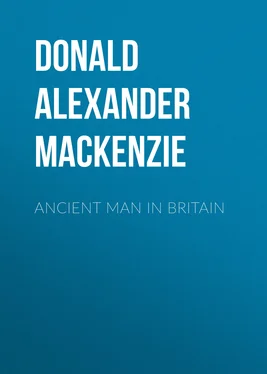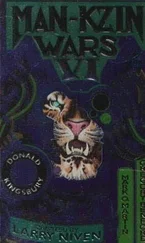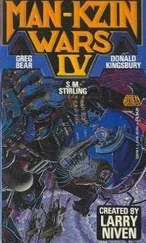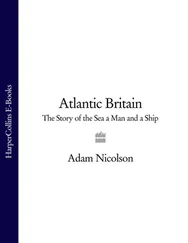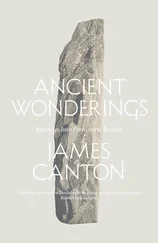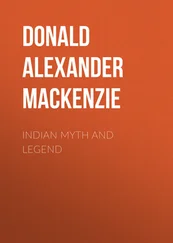Donald Alexander Mackenzie - Ancient Man in Britain
Здесь есть возможность читать онлайн «Donald Alexander Mackenzie - Ancient Man in Britain» — ознакомительный отрывок электронной книги совершенно бесплатно, а после прочтения отрывка купить полную версию. В некоторых случаях можно слушать аудио, скачать через торрент в формате fb2 и присутствует краткое содержание. Жанр: foreign_prose, История, Биология, foreign_edu, foreign_antique, на английском языке. Описание произведения, (предисловие) а так же отзывы посетителей доступны на портале библиотеки ЛибКат.
- Название:Ancient Man in Britain
- Автор:
- Жанр:
- Год:неизвестен
- ISBN:нет данных
- Рейтинг книги:3 / 5. Голосов: 1
-
Избранное:Добавить в избранное
- Отзывы:
-
Ваша оценка:
- 60
- 1
- 2
- 3
- 4
- 5
Ancient Man in Britain: краткое содержание, описание и аннотация
Предлагаем к чтению аннотацию, описание, краткое содержание или предисловие (зависит от того, что написал сам автор книги «Ancient Man in Britain»). Если вы не нашли необходимую информацию о книге — напишите в комментариях, мы постараемся отыскать её.
Ancient Man in Britain — читать онлайн ознакомительный отрывок
Ниже представлен текст книги, разбитый по страницам. Система сохранения места последней прочитанной страницы, позволяет с удобством читать онлайн бесплатно книгу «Ancient Man in Britain», без необходимости каждый раз заново искать на чём Вы остановились. Поставьте закладку, и сможете в любой момент перейти на страницу, на которой закончили чтение.
Интервал:
Закладка:
Considerable groups of the Stone Age men of Britain had achieved a remarkable degree of progress. They lived in organized communities, and had evidently codes of laws and regularized habits of life. They were not entirely dependent for their food supply on the fish they caught and the animals they slew and snared. Patches of ground were tilled, and root and cereal crops cultivated with success. Corn was ground in handmills; 3 3 A pestle or stone was used to pound grain in hollowed slabs or rocks before the mechanical mill was invented.
the women baked cakes of barley and wheat and rye. A rough but serviceable pottery was manufactured and used for cooking food, for storing grain, nuts, and berries, and for carrying water. Houses were constructed of wattles interwoven between wooden beams and plastered over with clay, and of turf and stones; these were no doubt thatched with heather, straw, or reeds. Only a small proportion of the inhabitants of Ancient Britain could have dwelt in caves, for the simple reason that caves were not numerous. Underground dwellings, not unlike the "dug-outs" made during the recent war, were constructed as stores for food and as winter retreats.
As flax was cultivated, there can be little doubt that comfortable under-garments were worn, if not by all, at any rate by some of the Stone Age people. Wool was also utilized, and fragments of cloth have been found on certain prehistoric sites, as well as spindle-whorls of stone, bone, and clay, wooden spindles shaped so as to serve their purpose without the aid of whorls, bone needles, and crochet or knitting-pins. Those who have assumed that the Early Britons were attired in skin garments alone, overlook the possibility that a people who could sew, spin, and weave, might also have been skilled in knitting, and that the jersey and jumper may have a respectable antiquity. The art of knitting is closely related to that of basket-making, and some would have it that many of the earliest potters plastered their clay inside baskets of reeds, and that the decorations of the early pots were suggested by the markings impressed by these. It is of interest to note in this connection that some Roman wares were called bascaudæ , or "baskets", and that the Welsh basged — basg , from which our word "basket" is derived, signify "network" and "plaiting". The decoration of some pots certainly suggests the imitation of wickerwork and knitting, but there are symbols also, and these had, no doubt, a religious significance.
It does not follow, of course, that all the Early Britons of the so-called Stone Age were in the same stage of civilization, or that they all pursued the same modes of life. There were then, as there are now, backward as well as progressive communities and individuals, and there were likewise representatives of different races—tall and short, spare and stout, dark and fair men and women, who had migrated at different periods from different areas of origin and characterization. Some peoples clung to the sea-shore, and lived mainly on deep-sea fish and shell-fish; others were forest and moorland hunters, who never ventured to sea or cultivated the soil. There is no evidence to indicate that conflicts took place between different communities. It may be that in the winter season the hunters occasionally raided the houses and barns of the agriculturists. The fact, however, that weapons were not common during the Stone Age cannot be overlooked in this connection. The military profession had not come into existence.
Certain questions, however, arise in connection with even the most backward of the Stone Age peoples. How did they reach Britain, and what attracted them from the Continent? Man did not take to the sea except under dire necessity, and it is certain that large numbers could not possibly have crossed the English Channel on logs of wood. The boatbuilder's craft and the science of navigation must have advanced considerably before large migrations across the sea could have taken place. When the agricultural mode of life was introduced, the early people obtained the seeds of wheat and barley, and, as these cultivated grasses do not grow wild in Britain, they must have been introduced either by traders or settlers.
It is quite evident that the term "Stone Age" is inadequate in so far as it applies to the habits of life pursued by the early inhabitants of our native land. Nor is it even sufficient in dealing with artifacts, for some people made more use of horn and bone than of stone, and these were represented among the early settlers in Britain.
CHAPTER II
Earliest Traces of Modern Man
The Culture Ages—Ancient Races—The Neanderthals—Crô-Magnon Man—The Evolution Theory—Palæolithic Ages—The Transition Period—Neanderthal Artifacts—Birth of Crô-Magnon Art—Occupations of Flint-yielding Stations—Ravages of Disease—Duration of Glacial and Inter-glacial Periods.
In 1865, Sir John Lubbock (afterwards Lord Avebury), writing in the Prehistoric Times , suggested that the Stone Age artifacts found in Western Europe should be classified into two main periods, to which he applied the terms Palæolithic (Old Stone) and Neolithic (New Stone). The foundations of the classification had previously been laid by the French antiquaries M. Boucher de Perthes and Edouard Lartet. It was intended that Palæolithic should refer to rough stone implements, and Neolithic to those of the period when certain artifacts were polished.
At the time very little was known regarding the early peoples who had pursued the flint-chipping and polishing industries, and the science of geology was in its infancy. A great controversy, which continued for many years, was being waged in scientific circles regarding the remains of a savage primitive people that had been brought to light. Of these the most notable were a woman's skull found in 1848 in a quarry at Gibraltar, the Cannstadt skull, found in 1700, which had long been lying in Stuttgart Museum undescribed and unstudied, and portions of a male skeleton taken from a limestone cave in Neanderthal, near Dusseldorf, in 1857. Some refused to believe that these, and other similar remains subsequently discovered, were human at all; others declared that the skulls were those of idiots or that they had been distorted by disease. Professor Huxley contended that evidence had been forthcoming to prove the existence in remote times of a primitive race from which modern man had evolved.
It is unnecessary here to review the prolonged controversy. One of its excellent results was the stimulation of research work. A number of important finds have been made during the present century, which have thrown a flood of light on the problem. In 1908 a skeleton was discovered in a grotto near La Chapelle-aux-Saints in France, which definitely established the fact that during the earlier or lower period of the Palæolithic Age a Neanderthal race existed on the Continent, and, as other remains testify, in England as well. This race became extinct. Some hold that there are no living descendants of Neanderthal man on our globe; others contend that some peoples, or individuals, reveal Neanderthaloid traits. The natives of Australia display certain characteristics of the extinct species, but they are more closely related to Modern Man ( Homo sapiens ). There were pre-Neanderthal peoples, including Piltdown man and Heidelberg man.
During the Palæolithic Age the ancestors of modern man appeared in Western Europe. These are now known as the Crô-Magnon races.
In dealing with the Palæolithic Age, therefore, it has to be borne in mind that the artifacts classified by the archæologists represent the activities, not only of different races, but of representatives of different species of humanity. Neanderthal man, who differed greatly from Modern man, is described as follows by Professor Elliot Smith:
Читать дальшеИнтервал:
Закладка:
Похожие книги на «Ancient Man in Britain»
Представляем Вашему вниманию похожие книги на «Ancient Man in Britain» списком для выбора. Мы отобрали схожую по названию и смыслу литературу в надежде предоставить читателям больше вариантов отыскать новые, интересные, ещё непрочитанные произведения.
Обсуждение, отзывы о книге «Ancient Man in Britain» и просто собственные мнения читателей. Оставьте ваши комментарии, напишите, что Вы думаете о произведении, его смысле или главных героях. Укажите что конкретно понравилось, а что нет, и почему Вы так считаете.
